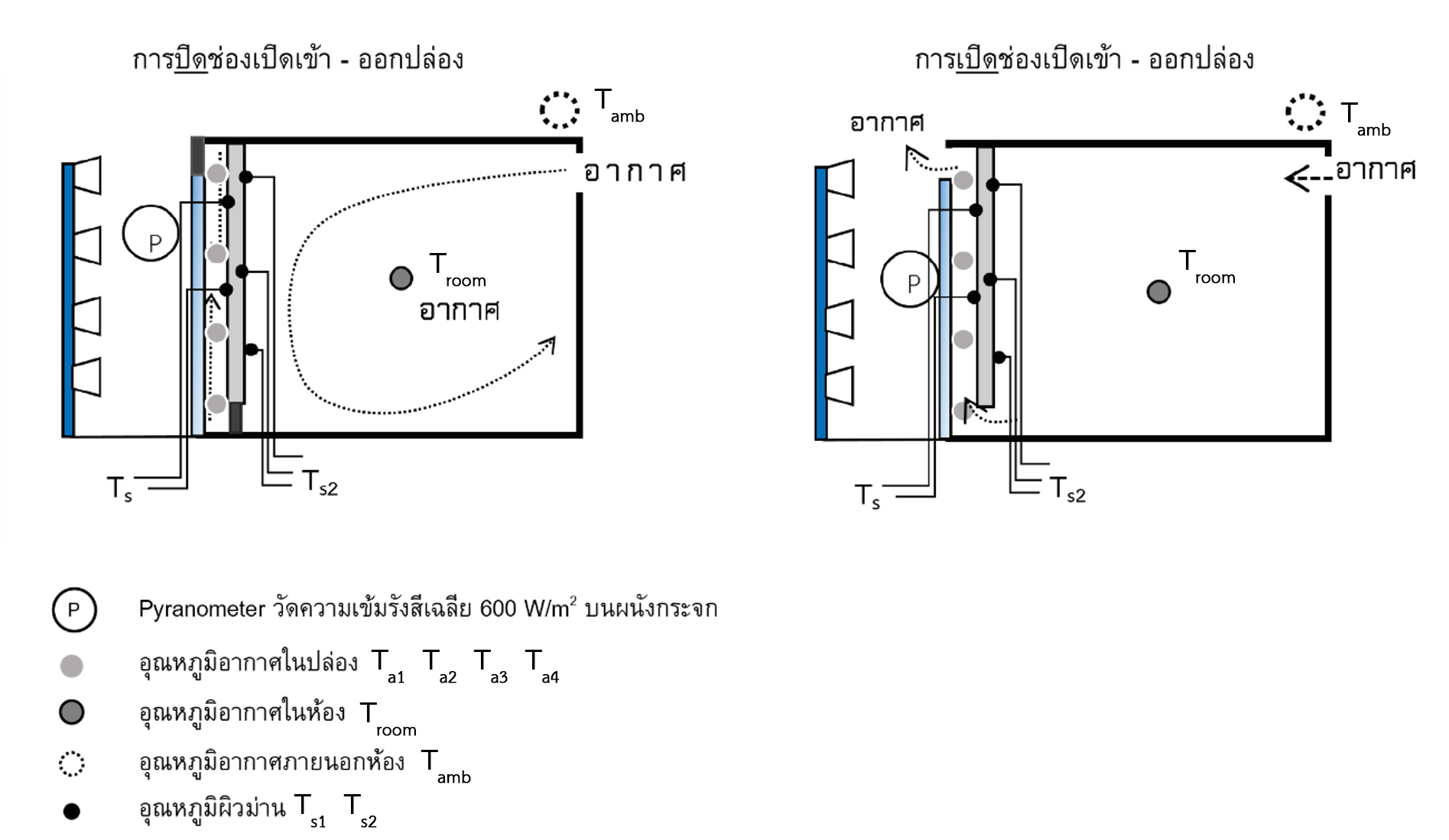Utilization of a Glass Wall Curtain in the Ventilated Chimney to Reduce Temperature in Non-air Conditioned Room
Main Article Content
Abstract
The high temperature of the curtain surface and the warm air in the gap between the glass and the curtain flows into the room. This research studies utilization of the air gap for ventilation to reduce room temperature. The thermal performance of dim-out, blackout and aluminum-coat reflective curtains, are studied. The curtain was installed at 14 cm from the glass pane to perform an inner wall of the air gap. There were two openings, one at the top of the glass to let warm air flowing out of the air gap and one opening at the bottom of the curtain to let room air flowing into the air gap. The results of ventilated air gap were compared with the closed air gap. For a constant solar intensity of 600 W/m2, the results showed that the surface temperature of the curtains with ventilated air gap is lower than those with closed air gap by 2.2 - 5.4 °C. The surface temperature of aluminum-coat reflective curtains is lowest among three curtains. The surface temperatures of all curtains were 7.6 - 12.4 °C higher than room temperature because the hot air leaked through the cloth pores and flowed into the room. The typical curtain clothes with low thermal resistance affects the ventilation performance. Therefore, this research recommended insulation materials with thermal reflective coating on the outer surface for a widow curtain. The minimum thermal resistance of 0.94-1.0 °Cm2/ W was suggested to reduce room air temperature by 6 °C.
Downloads
Article Details

This work is licensed under a Creative Commons Attribution-NonCommercial-NoDerivatives 4.0 International License.
All material is licensed under the terms of the Creative Commons Attribution 4.0 International (CC-BY-NC-ND 4.0) License, unless otherwise stated. As such, authors are free to share, copy, and redistribute the material in any medium or format. The authors must give appropriate credit, provide a link to the license, and indicate if changes were made. The authors may do so in any reasonable manner, but not in any way that suggests the licensor endorses you or your use. The authors may not use the material for commercial purposes. If the authors remix, transform, or build upon the material, they may not distribute the modified material, unless permission is obtained from JARS. Final, accepted versions of the paper may be posted on third party repositories, provided appropriate acknowledgement to the original source is clearly noted.
References
Bansal, N. K. Mathur, R., & Bhandari, M. S. (1993). Solar chimney for enhanced stack ventilation. Building and Environment, 373-377.
Cengel, Y. A., & Ghajar, A. J. (2014). Heat and Mass Transfer. Singapore: McGraw-Hill.
Chantawong, P., Ungkoon, Y., Vimanja, V., Sotprawati, B., Chumchan, C., Krasaelom, N., Phuetsaka, P., Saengviroon, P., Thantong, P., Sompate, K., Aranyik, P., & Thepwacharakarun, M. (2012). Natural Ventilation of House Models Utilizing Glazed Solar Chimney Walls with Vertical Blinds for the Hot Humid Climate of Bangkok. The Journal of KMUTNB, 22(3).
Chungloo, S., & Limeechokchai, B. (2007). Application of passive cooling systems in the hot and humid climate: The case study of solar chimney and wetted roof in Thailand. Building and Environment, 42, 3341-3351.
Hassanein, S. A., & Abdel-Fadeel, W. A. (2012). Improvement of Natural Ventilation in Building Using Multi Solar Chimneys at Different Directions. Journal of Engineering Sciences, Assiut University, 40(6), 1661-1677.
Inoue, K. (2015). Specification of the blackout curtain. Retrieved from https://www.scientex.co.jp/english/blackoutcurtain.html
Khedari, K., Hirunlabh, J., & Bunnag T. (1997). Experimental study of a roof solar collector towards the natural ventilation of new houses. Energy and Buildings, 159-164.
Office of the Royal Society. (2011). Royal Institute Dictionary. Bangkok: Office of the Royal Society.
Ongwuttiwat, K., Sudprasert, S., & Leephakpreeda, T. (2018). Determination of human thermal comfort due to moisture permeability of clothes. International Journal of Clothing Science and Technology, 462-476.
Shi, L., Zhang, G., Yang, W., Huang, D., Cheng, X., & Setunge, S. (2018). Determining the influencing factors on the performance of solar chimney in buildings. Renewable and Sustainable Energy Reviews, 223-238.
Sudprasert S., & Luukkanen J. (2017). Comparison of Ventilation with Moist and Dry Air in the Room Connecting to a Solar Chimney. BUILT: International Journal of Building, Urban, Interior and Landscape Technology, 8-15.
Woodthanan, S. (2012). The production process for energy-saving curtains and curtains obtained from this process. Petty Patent 7546. Thailand


